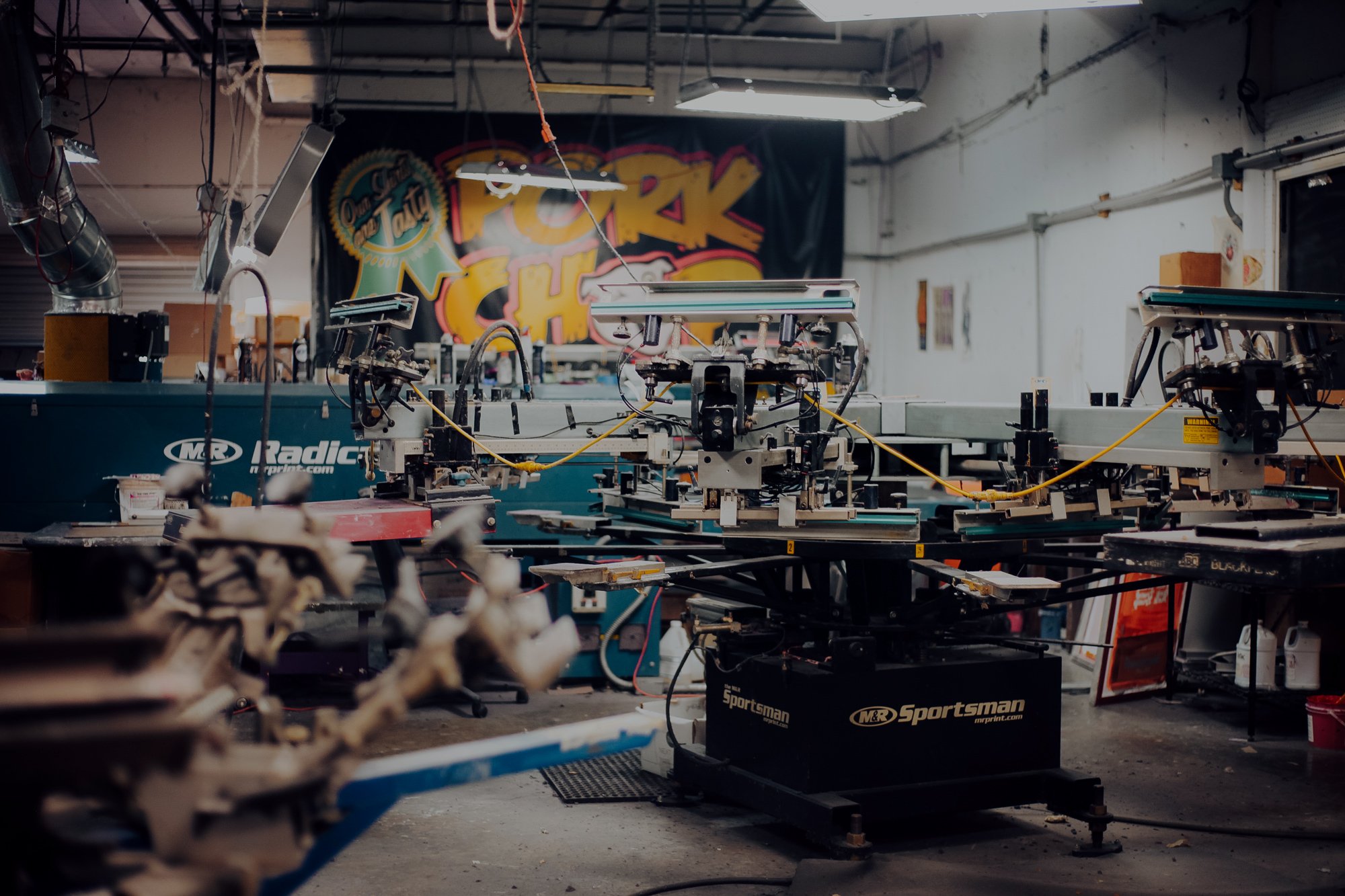Durable T-Shirt Printing for Everyday Wear
Durable T-Shirt Printing for Everyday Wear
Blog Article
Display Printing Uncovered: Whatever You Required to Learn About Tee Shirt and Garment Printing Strategies
If you've ever questioned how those lively designs wind up on your favorite t-shirts, you're in the ideal area. Screen printing is an interesting method that integrates art with technique, offering unlimited opportunities for imagination. Understanding the fundamentals, from devices to ink selections, can greatly influence your results. All set to check out the important aspects that make display publishing an art type? Allow's reveal the information that can boost your tasks.
The Fundamentals of Display Printing: How It Works
When you dive into screen printing, you'll uncover it's both a science and an art. At its core, screen printing involves producing a stencil, or screen, that allows ink to pass through just in details locations (screen printing kit). You start by choosing your style and preparing your display with a light-sensitive emulsion. Once you reveal this emulsion to light, it hardens, leaving your layout as an adverse space.
Next, you'll blend your inks and prepare your printing surface. Position the display over the material, then utilize a squeegee to press ink through the screen onto the garment. This procedure calls for accuracy, as you want clear, lively prints. After printing, you'll treat the ink with heat, ensuring it adheres to the fabric and lasts with cleans. Each action is essential, and mastering them will raise your display printing abilities, transforming simple garments right into distinct, meaningful pieces.
Kinds of Display Printing Techniques
When you understand the fundamentals of screen printing, it's time to check out the numerous strategies that can elevate your designs. One popular technique is conventional screen printing, where ink is pressed with a stenciled screen. This technique is fantastic for vibrant, vibrant colors. There's water-based ink printing, which uses a softer feeling and is eco-friendly, however it needs a different method to treating.
An additional choice is plastisol printing, understood for its longevity and brilliant shades, making it a favored for numerous brands. Experiment with halftone printing to develop gradient impacts and intricate layouts.
Vital Tools for Screen Printing
To attain magnificent results in screen printing, having the best devices is fundamental. You'll require a strong display printing framework, which holds the mesh that transfers your layout onto the garment. Next off, spend in premium mops; these are essential for applying ink evenly throughout the display.
Selecting the Right Inks and Products
When selecting inks and materials for screen printing, you require to take into account the sort of ink that works best for your job. Assume concerning material compatibility to assure your designs look excellent and last lengthy. Additionally, explore eco-friendly ink options to make your printing process a lot more lasting.
Kinds Of Screen Inks
Picking the best screen ink is vital for attaining vivid, long lasting prints that meet your task's needs. There are numerous kinds of display inks to analyze. Plastisol ink is prominent for its versatility and simplicity of use, offering outstanding color opacity on dark textiles. Water-based ink, on the other hand, provides a softer feeling and is environmentally friendly, making it excellent for those seeking to minimize their ecological effect. Release inks eliminate color from the fabric, leading to a soft, classic look however call for particular handling. Finally, specialized inks, such as metal or glow-in-the-dark, can include distinct effects to your designs. Examine your task requirements and select the ink that straightens best with your wanted end result.

Fabric Compatibility Considerations
Comprehending fabric compatibility is crucial for accomplishing premium display prints, especially given that different products respond distinctively to various inks. When picking inks, think about the material type-- cotton, polyester, or blends. For cotton, water-based inks work well, supplying gentleness and breathability. Polyester, on the various other hand, frequently requires plastisol inks for better attachment and vivid shades. If you're printing on blends, you could need to make use of a combination of both types. Always evaluate your inks on example textile to assure they adhere effectively and preserve color stability. Additionally, bear in mind that textile weight and texture can affect the final outcome, so picking the ideal ink and product combo is crucial for your task's success.
Eco-Friendly Ink Options
Eco-friendly inks are becoming a preferred choice for display printers who wish to minimize their ecological impact while preserving high quality. When picking inks, think about water-based inks, which are much less unsafe and much easier to cleanse up compared to standard solvents. These inks bond well with textiles, supplying vibrant outcomes without poisonous chemicals. You could also discover eco-solvent inks that make use of fewer unstable organic compounds (VOCs), making them a more secure choice for both your wellness and the earth.
In addition, search for inks made from renewable energies, such as soy or vegetable-based alternatives. By choosing the ideal inks and products, you'll not just develop magnificent layouts however likewise add to an extra lasting printing process. Make the button, and your prints will certainly mirror your dedication to the environment!
Preparing Your Style for Display Printing

Submit Style Requirements
To guarantee your design looks dynamic and sharp on fabric, you'll require to pay close focus to submit format demands for display printing. Make sure your layout has a clear background to stop undesirable white sides on your prints. Keep shade settings in mind; CMYK is standard for screen printing, so transform your RGB creates accordingly.
Color Separation Methods
Shade splitting up is a necessary action in preparing your layout for screen printing, and mastering it can substantially boost your print quality. You'll need to damage your design into private shades, as each color calls for a different screen during printing. Beginning by identifying all the colors in your layout and develop layers for each one. You can utilize software like Adobe Photoshop click to find out more or Illustrator to separate and separate colors efficiently. Be particular to save each layer as a separate documents, normally in a layout like TIFF or PSD. This precision not just guarantees accurate shade depiction however additionally improves the printing procedure. By taking notice of color separation, you'll achieve vivid and expert lead to your screen-printed garments.
Resolution and Size
Accomplishing the best lead to screen printing begins with assuring your style has the ideal resolution and dimension. Preferably, your art work needs to go to least 300 DPI (dots per inch) for sharp, clear prints. If you use lower resolution, your end product may look unprofessional and pixelated.
When it involves dimension, take into consideration the dimensions of your print area. Design your artwork to match the last print size, ideally creating it in the real dimensions you'll be printing. By doing this, you'll stay clear of any kind of unforeseen scaling concerns.
Constantly check your design in both vector and raster layouts. Vector graphics can be scaled without shedding quality, making them suitable for screen printing. Preparing correctly will assure your layout looks amazing on every garment!
Step-by-Step Display Printing Refine
Display printing is a dynamic process that allows you to produce vivid designs on various surface areas. To find this start, you'll need a screen, solution, and your picked ink. Prepare your screen by cleaning it extensively. Next off, apply the solution equally and let it completely dry in a dark location. When completely dry, reveal your screen to light with your style positioned on it, which will certainly harden the solution where the light hits, developing a stencil - screen printing kit.
After cleaning out the unexposed emulsion, your screen prepares. Establish it up on your printing surface area and straighten your garment under it. Put ink onto the display and make use of a squeegee to press the ink via the stencil onto the fabric. Lift the display thoroughly and let the print completely dry. Finally, heal the ink using warmth to over here guarantee longevity. That's it! You have actually effectively display published your layout.
Tips for Successful Display Printing Projects
While you're diving into your display printing projects, keep in mind that preparation is key to success. Start by collecting all your products-- inks, screens, garments, and mops. A tidy work space helps avoid unwanted errors, so clean up prior to you start.
Following, verify your art work is high-resolution and effectively sized for your garment. Evaluate your display for correct exposure and tidy it extensively to stay clear of smudges. When mixing your inks, comply with the producer's standards to attain the ideal uniformity.
Throughout printing, use also stress with your squeegee for constant results. Do not rush; take your time to validate each print fulfills your requirements. After printing, allow your garments dry completely before dealing with or packaging them.
Last but not least, always maintain an example of your benefit future recommendation. In this manner, you can examine your progression and improve your strategies gradually. Satisfied printing!

Often Asked Inquiries
For how long Does It Require To Establish a Display Printing Task?
Setting up a display printing task normally takes around thirty minutes to an hour. You'll prepare the screens, mix inks, and adjust the press. The moment varies based on complexity and experience, so remain arranged!
Can I Publish on Various Textile Types Utilizing the Exact Same Strategy?
Yes, you can publish on different material types making use of the same technique, however you'll need to change your inks and settings. Some fabrics take in ink in a different way, so experimenting assurances the most effective results for each and every product.
What Prevail Blunders to Prevent in Screen Printing?
When display printing, prevent typical errors like using the incorrect ink, neglecting appropriate direct exposure times, or missing pre-press checks. Constantly test your configuration and preserve tidy displays to ensure quality outcomes each time.
How Can I Correctly Clean and Preserve My Screen Printing Devices?
To effectively clean and keep your display printing equipment, you should on a regular basis clean displays with proper solvents, examine squeegees for wear, and assure all devices are stored dry and dust-free. Uniformity enhances and prevents costly repair services efficiency.
Is Screen Printing Ecologically Friendly Contrasted to Other Methods?
Screen printing can be much more ecologically friendly than various other techniques, specifically if you use water-based inks and eco-conscious products. By choosing lasting supplies and techniques, you decrease waste and minimize your influence on the earth.
Screen Printing Uncovered: Whatever You Required to Know Concerning Tee Shirt and Garment Printing Techniques
At its core, display printing includes developing a stencil, or screen, that permits ink to pass with only in particular areas. Placement the screen over the textile, then utilize a squeegee to push ink with the screen onto the garment. One prominent technique is typical display printing, where ink is pressed with a stenciled screen.When selecting inks and products for screen printing, you need to take right into account the type of ink that functions finest for your job.
Report this page